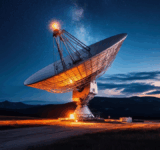Geopolitical tensions mean GPS can no longer be take for granted, stresses Alastair MacLeod, CEO of Ground Control, and A-PNT is coming to the forefront
With geopolitical tensions at an all-time high, and technology evolving faster than ever before, one truth is becoming increasingly difficult to ignore: our reliance on GPS can no longer be taken for granted. For decades, the Global Positioning System has quietly underpinned everything from military operations to everyday logistics. But as adversaries develop ever more sophisticated tools to jam and spoof satellite signals, defence forces are leading a vital shift, building resilient, multi-layered systems to ensure that positioning, navigation, and timing (PNT) data remains accurate and dependable in even the most hostile environments.
GPS, operated by the US military and available globally, revolutionised modern navigation. But its inherent weakness lies in the fragility of its signals. Transmitted from satellites orbiting some 20,000 kilometres above Earth, signal strength wanes by the time it reaches the ground, making it vulnerable to hostile disruption.
Jamming devices that block these signals and spoofers that feed systems false location data are no longer confined to high-end military arsenals. They are increasingly cheap, portable and accessible, and the impact is already being felt. In recent years, aircraft, ships and even mobile phones have experienced unexplained navigation errors or dropouts, often traced back to GPS interference.
Faced with this threat landscape, defence organisations are investing in diverse, layered alternatives, not to replace GPS, but to strengthen it through redundancy, augmentation and resilience.
Building a resilient ecosystem
As threats to satellite performance in contested environments become more common, defence strategy has shifted from relying on any single system to adopting a layered, multi-technology approach. By integrating a combination of complementary systems it is possible to maintain operational effectiveness even when signals are denied or degraded.
From space-based alternatives to terrestrial and mesh-based communications, the focus is on building a resilient ecosystem that ensures continuity. In this context, reliable connectivity becomes just as important as accurate positioning. When assets on the ground, at sea or in the air need to share data securely and instantly, regardless of whether GPS is functioning, that’s where trusted satellite communications infrastructure comes into play.
In this broader shift toward resilience, reliable alternatives are a fundamental part of the solution.
Technologies operating on Low Earth Orbit satellite constellations, including those used in field-proven devices, contribute to that continuity by enabling information to move in and out of disrupted environments. While not a substitute for navigation systems, these tools can support the wider ecosystem by ensuring that essential data – however small the packet – can still be shared when it matters most.
A-PNT: a companion not a replacement
Among the most significant technological advances is A-PNT, delivered via Low Earth Orbit satellites. Unlike GPS, which operates from Medium Earth Orbit and is vulnerable to jamming and spoofing, A-PNT provides stronger signals at ground level and uses encrypted transmissions for added security. This makes A-PNT more reliable in environments where GPS often falters, such as inside buildings or dense urban areas.
Importantly, A-PNT is not a replacement for GPS. It is designed to work alongside it, providing an additional layer of resilience in critical environments. Whether on the battlefield, at sea, or in complex urban settings, A-PNT offers trusted timing and positioning data when GPS alone may not be sufficient. It also supports secure communications and operational continuity.
While broader approaches to resilient navigation may include technologies like inertial systems, RF, and mesh networking, our focus is on delivering A-PNT in combination with GPS, a practical, immediate step toward stronger positioning resilience that is now being adopted well beyond defence. As navigation systems face increasing threats from jamming and spoofing, defence strategies are placing greater emphasis on the resilience of communications infrastructure. When GNSS/GPS data is unavailable or unreliable, the ability to maintain secure, low-bandwidth data links becomes vital, enabling critical systems to continue sharing situational information, telemetry, or status updates in real time.
Satellite networks that offer global coverage and are less susceptible to interference are playing a growing role in this effort. They help ensure that, even when navigation is contested, communication lines remain open, providing a crucial layer of operational continuity in complex or degraded environments.
Civilian infrastructure: learning from defence
When it comes to technological innovation, what begins on the battlefield more often than not finds its way into the civilian and commercial world. From autonomous vehicles to energy networks and emergency services, a wide range of sectors are beginning to recognise the implications of GPS vulnerability and the potential consequences of disruption.
The rapid growth of IoT, with billions of connected devices dependent on real-time location and timing data, has added another layer of complexity. In these densely interconnected systems, even brief interruptions in positioning or timing can lead to cascading failures.
A future built on redundancy
The threats to GPS are not going away. In fact, they’re growing, not just in intensity, but in sophistication and reach. Defence forces understand this reality better than most, which is why they’re leading the transition towards a world where navigation and timing are underpinned by multiple, integrated systems and layers.
But this is not a story of obsolescence. GPS is, and will remain, a cornerstone of global navigation. What’s changing is how it’s supported. By surrounding GPS with complementary technologies like A-PNT, inertial systems and advanced communications, organisations are building a future where navigation is not only smarter, but unbreakable.
Ground Control is playing a pivotal role in that transformation. By offering a full spectrum of navigation and data solutions, from traditional GPS to next-generation satellite communication, it is helping defence and civilian sectors alike prepare for whatever the future holds.
In a world where certainty matters more than ever, resilience is crucial. And it starts with asking the right question: not ‘what if GPS fails?, but ‘are we ready when it does?

Alastair MacLeod is the CEO of Ground Control, a Group comprising three companies – Wireless Innovation, Rock Seven and Ground Control (US).
Alastair has a passion for deep tech and data, IoT, AI and M2M, with Ground Control specialising in satellite and cellular technology to connect people and things, particularly within hard to reach, remote areas – from wind farms to fishing fleets and first responders to forestry workers.
There’s plenty of other editorial on our sister site, Electronic Specifier! Or you can always join in the conversation by visiting our LinkedIn page.










